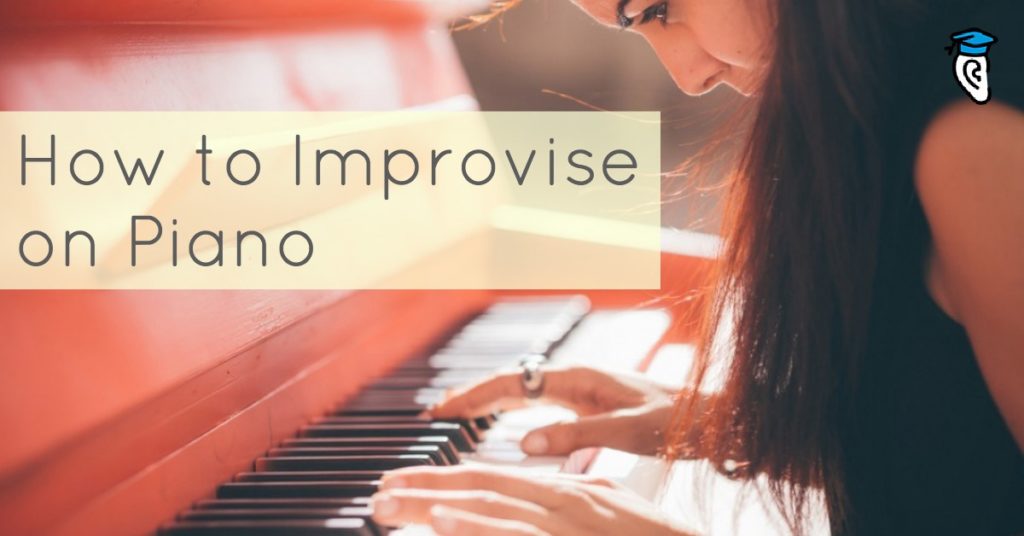Piano is probably the most versatile of instruments in the variety of arrangements, styles and complexity of music it can produce – making it both one of the most powerful and most intimidating instruments for learning to improvise. Fortunately there are some simple steps you can take to gradually become an expert piano improviser.
It’s a taboo among musicians to claim that one instrument is harder than another to learn, but something we’ve been discussing inside Musical U lately is that piano is simply harder than other instruments. It requires an independence and coordination of your two hands in a way that no other instrument really does. It means teaching your brain to process two (potentially quite different) streams of music and integrate them in a coherent way. This all just exacerbates the problem I discussed last week in Improvisational Freedom Through Constraints: that beginners to improvisation can easily feel overwhelmed by the sheer number of options available to them with every note choice they make.
When you sit down at a piano to improvise, not only do you need to make the big decisions like what musical style you’ll play in and what emotions you want to convey, but you then also need to decide beat-by-beat what each of your ten fingers (not to mention those feet on the pedals) will do. Without some kind of framework to help you, this is, frankly, insanely difficult.
So in this article I wanted to present some ideas for getting started with piano improvisation which can help you break past that overwhelm and begin to explore improvisation in a fun, musical way that lets your inner musician out.
Before diving in I’d recommend taking a look at these three background articles that give some valuable general principles for learning to improvise music freely and confidently:
- Improvising Music: The Basics
- How To Start Improvising Music in 6 Steps
- Improvisational Freedom Through Constraints
With those principles under your belt, let’s look at some piano specifics for learning to improvise. There are five stages that I’d recommend you go through.
1. Melodies, one hand at a time

The first thing I’d say is: start one hand at a time. This is an idea which is familiar to every Grade 1 or Grade 2 piano student but it’s often then forgotten as the student progresses and it may be overlooked when it comes to improvisation. For example, even the rare teacher who helps their students to improvise will often begin by expecting them to maintain a left-hand harmony part while beginning to improvise with their right-hand over the top. That’s already quite a lot to do!
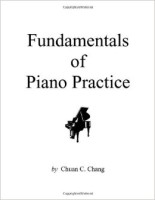 Instead, I recommend beginning one hand at a time, even if you are quite technically proficient on piano. Remember: you are teaching your brain as much as your fingers here. The excellent book Fundamentals of Piano Practice recommends always learning pieces “Hands Separately” before attempting “Hands Together” and I think the same strategy is smart for improvisation.
Instead, I recommend beginning one hand at a time, even if you are quite technically proficient on piano. Remember: you are teaching your brain as much as your fingers here. The excellent book Fundamentals of Piano Practice recommends always learning pieces “Hands Separately” before attempting “Hands Together” and I think the same strategy is smart for improvisation.
So begin one hand at a time. And although we tend to think of piano arrangements as being “left hand harmony, right hand melody”, with that right-hand part getting increasingly complicated and polyphonic itself, I would suggest keeping it as simple as possible to start out. Meaning play simple improvised one-note-at-a-time melodies in one hand, and then do the same in the other.
A few tips here:
- Use the idea of improvisational rules to make things so simple that your inner musical instinct can’t help but start to emerge.
- Repeat yourself. Instead of trying to make each phrase different and new, let yourself repeat little phrases, licks and riffs, and experiment with changing them just slightly each time. This is a shortcut to improvisation that sounds more intentional and proficient, rather than you producing a continually-changing seemingly-random stream of notes.
- Use a backing track or play with a friend, so that even if you are playing just simple melodies, you can still feel like you are making interesting music.
Once you start getting comfortable with improvising melodies in each hand, you can move on to harmonies. Which brings us to stage two.
2. Learn your triad chords
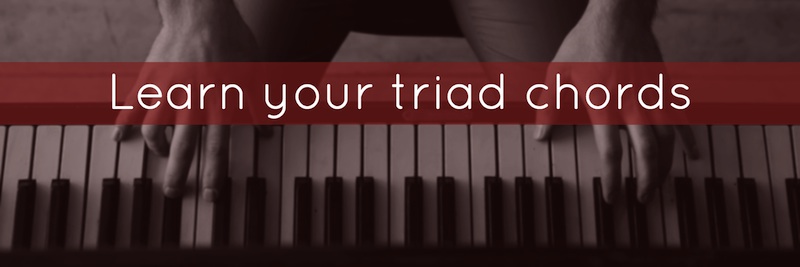
For me personally this was the major breakthrough in piano improvisation. After a few years of lessons, learning to play pieces and sight-read music, I finally spent a couple of weeks simply learning each of the 24 major and minor triad chords, in both hands. Playing block chords, then playing around with their arpeggios. Learning to play arpeggios across multiple octaves, linking the hands together.
To some extent this is part of the traditional piano syllabus: you learn your scales and the corresponding arpeggios. But teaching myself to think in terms of triads and the visual patterns they created on the keyboard gave me a whole different way to approach the keys in front of me.
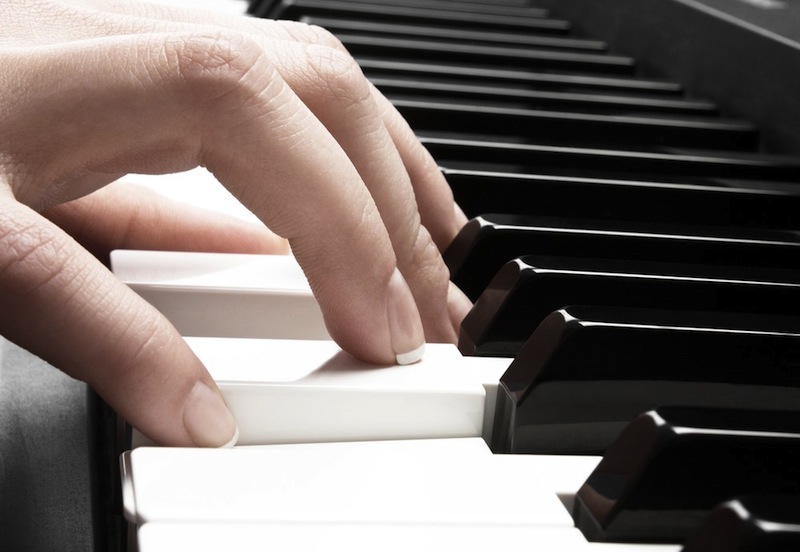
It may seem like an arbitrary task to begin with, like learning theory for the sake of it, but get to know those basic major/minor triad shapes, and quickly the keyboard starts coming to life in a way that learning pieces alone doesn’t really deliver.
Tip: Don’t know the fingerings for the major and minor triads? Just do a Google Image Search for “piano chords chart” to find plenty of references you can use or watch this video.
How do chords help you improvise?
Well, as Duane Shinn (whose piano-by-ear materials I would recommend) would put it, thinking in terms of chords lets you “play more notes without reading more notes”. Or in the case of pure improvisation, to play more notes without having to choose more notes. It gives you bigger musical blocks to use in your improvisation, which lets your improvisations get more complex and sophisticated musically, without requiring you to apply massive brainpower to deciding lots of notes very quickly!
This is also an approach recommended by Joseph Pingel of Keyed Up Piano – learn more about his approach to playing by ear here: The Play-By-Ear Mystery Revealed.
Why triads?
Major and minor triads are the most basic form of chords. They sound relatively simple, but learn those shapes and study chord progressions like the “one four five” and you’ll be equipped with some powerful building blocks for creating interesting improvisations.
To explore this approach, simply learn those triads, one key at a time, and start playing around with them. For example: Decide to learn the main triads in the key of C Major, which would be C Major, F Major, G Major and A Minor. Spend time just practising transitioning between those chords in different combinations and voicings, playing them as blocks or arpeggios in different ways. One hand at a time and then start trying both together.
When you feel confident, you can begin to integrate this with what you did in step one, playing simple C Major scale melodies in your right hand over C-F-G-Am chords in your left hand.
Noodling around in this way doesn’t take long to learn – but if you’ve previously been a “sheet music only” musician it can truly transform your relationship with music and give you an early glimpse of the freedom that becoming a “play by ear” musician brings.
3. Play from Lead Sheets
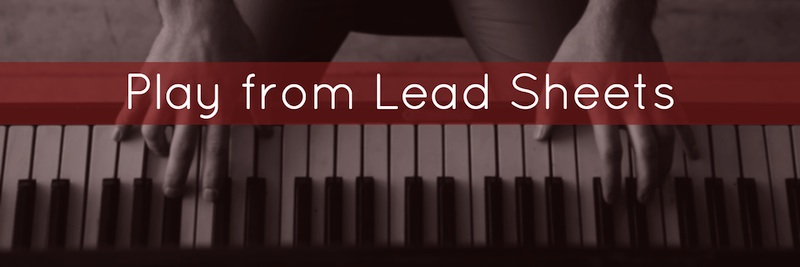
Now that you’re starting to think in terms of chords and melodies and approach the keyboard in a different way, your biggest resource to take things to the next stage will be lead sheets.
These are simple versions of sheet music which normally provide one example of each section (i.e. one verse with one chorus) of a song, with just the melody and chord symbols. So instead of having full sheet music showing every note you should play, you’re starting from just the bare skeleton of the piece.
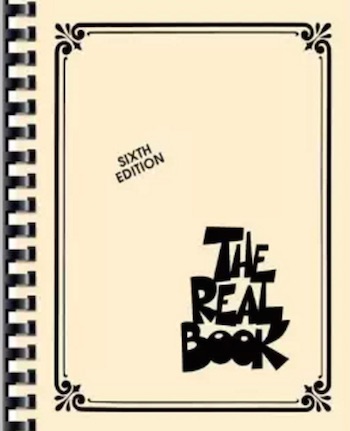 Lead sheets are most commonly associated with jazz music where a single spiral-bound book can hold a couple of hundred songs! But they are also now commonly used and available for pop and rock music, as well as being a standard tool for song-writers and bands to concisely capture the basics of a song.
Lead sheets are most commonly associated with jazz music where a single spiral-bound book can hold a couple of hundred songs! But they are also now commonly used and available for pop and rock music, as well as being a standard tool for song-writers and bands to concisely capture the basics of a song.
How do Lead Sheets help you improvise?
There are two benefits to using lead sheets in learning to improvise.
1. They teach you to improvise an arrangement. This is a really valuable skill. It means that you break beyond simply playing each chord once per bar (or once per beat) and playing through a melody over the top, and instead start bringing real musical style to your improvisations.
A lead sheet challenges you to think of how you want the song to sound – and then make it happen. You don’t need to decide the chords, or how to play the melody by ear – but you do need to fill in pretty much everything else! That includes:
- A suitable lead-in and outro
- The overall structure: how many verses and choruses, if and how to use the bridge, how to vary dynamics verse to verse, whether to adjust the tempo, and so on
- The musical style: how exactly are you going to play each of those chords? Voicing, rhythm, left and right hand coordination, etc.
From the basic skeleton you can learn to create interesting and sophisticated renditions, different every time you play them.
2. They give you a context to improvise in. Again, this is particularly relevant for jazz, where there’s the tradition of instruments each “taking a solo” in the middle of a piece. But you can use the same idea in any style.
Here’s a simple way to get started: After playing through the verse and chorus once, play through the verse chords again, but this time improvise in your right hand instead of playing the melody. Keep it simple to begin with (constraints again!) and try to follow the chord tones. It will help if you play at a slightly slower tempo than usual.
As you practice playing from the same lead sheet again and again you’ll get a feel for how best to use the notes of the key to give your solos character. This will work together with your work on improvising arrangements, so that your overall rendition of each song, both playing the traditional melody and your improvisation in the middle, become more and more musically compelling.
To get started with this you can look up lead sheets online or buy a book in your favourite style. Look for books described as “guitar chords plus vocal”, “lead sheets” or “fake books”.
4. Improvising from scratch
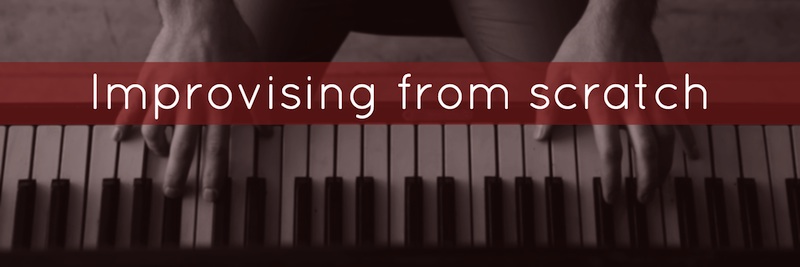
As you gain more confidence in improvisation and want to go beyond the basic triad chords and lead sheet approaches, you can explore other frameworks for improvisation.
One which I wanted to highlight is the Pianobreaks system. Its creator Mark Meronek recently featured in our Jazz Improv Experts Guide and also wrote a great guest post on jazz improvisation for us.
The Pianobreaks system is elegant because it very quickly teaches you to play great-sounding jazz improvisations using very simple building blocks, all well within the reach of any beginner-to-intermediate level pianist.
I love that Mark focuses on the emotion and instinct of improvisation and teaches you to develop your relationship with the keyboard. It’s an approach that very closely complements the “constraints thinking” mentioned above: by keeping it simple, you actually gain more freedom.
You can try out free video tutorials from the Pianobreaks system here.
5. Becoming more versatile

If you’ve worked through the four stages above you’ll now be quite a confident piano improviser. You are able to sit down at the keyboard, either with a lead sheet or no music at all, and create great-sounding performances from your own musical imagination, and feel confident doing it.
Now it’s time to push yourself to new limits. One effective way to do this is by expecting yourself to improvise in various styles.
Can you improvise the soundtrack for a cat-and-mouse chase in a cartoon?
Could you play something suitable for a weepy romantic scene in a film?
If you had to accompany a friend’s serious spoken-word performance at short notice, or play background music at a wedding, could you do it?
Famed performer “Harry the Piano” is a great example of this. Described as “The best damn pianist in the civilised world”, Harry excels in playing improvised arrangements in any style imaginable.
Interested in learning to do this yourself? You’re in luck. Harry teamed up with leading theory site DaveConservatoire.org to offer a series of simple tutorials explaining his approach.
This is where you become a truly impressive improviser, able not only to create great-sounding music from scratch on demand, but be able to do so in whatever style or structure is required. This is the kind of improvising pianist that is in high demand!
Take the first steps
If you’re just starting out with piano improvisation then what I’ve described above is a journey that could easily occupy you for the next five to ten years. But don’t let that intimidate you! I can’t stress enough how quickly those first couple of steps can go if you already have some basic ability on piano, and how rewarding, satisfying and simply fun they are.
If you play some piano but have felt bound to the sheet music and wished you could improvise, I hope you’ll give these first couple of steps a try. If you’re already improvising I hope some of the other steps presented here give you new ideas to advance your skills. Whatever stage you’re at, find a way to let that inner musical instinct come out – and have fun with it!

